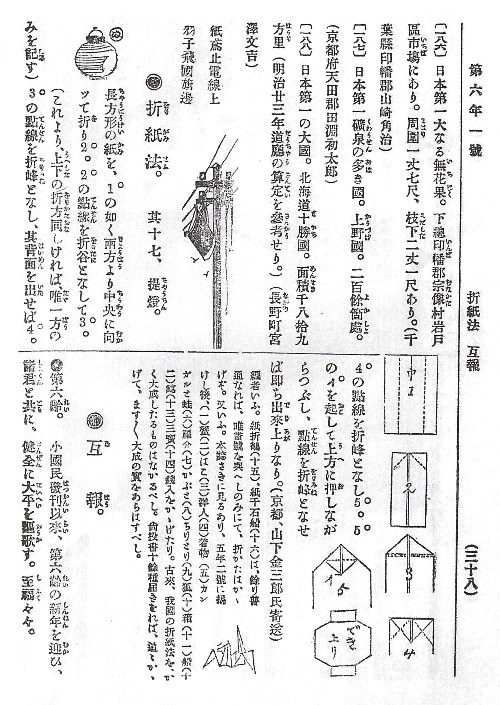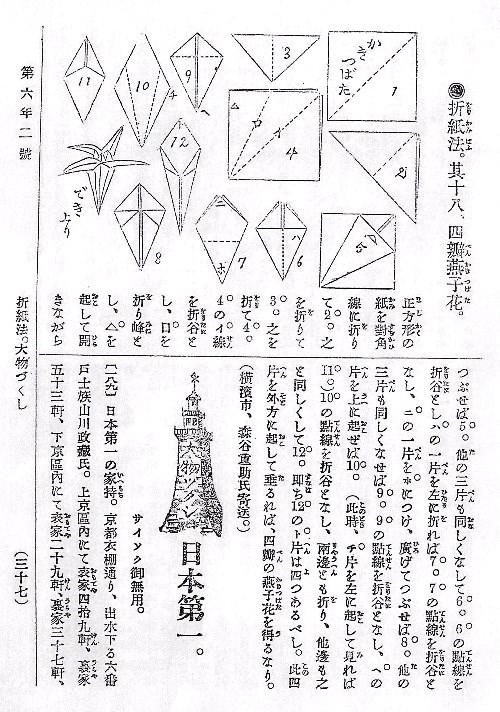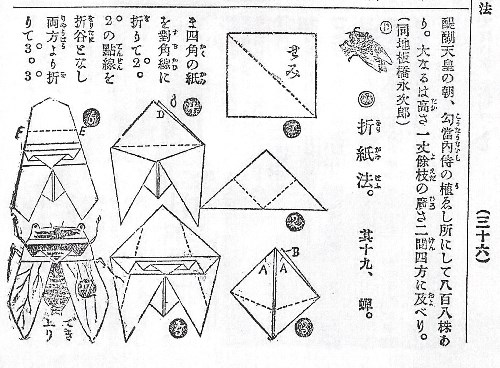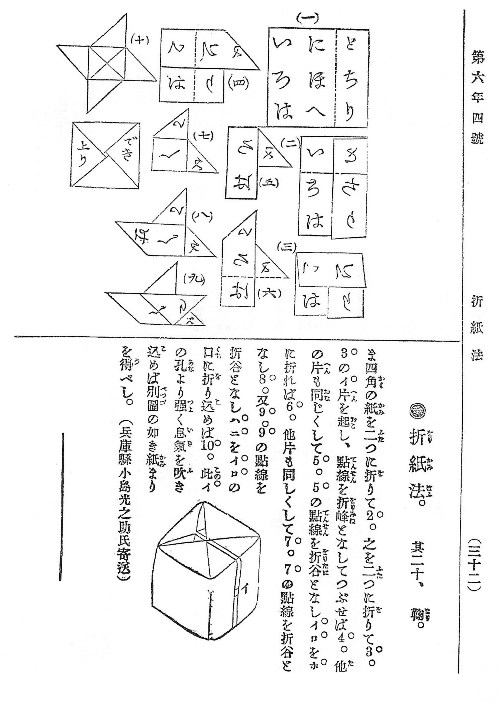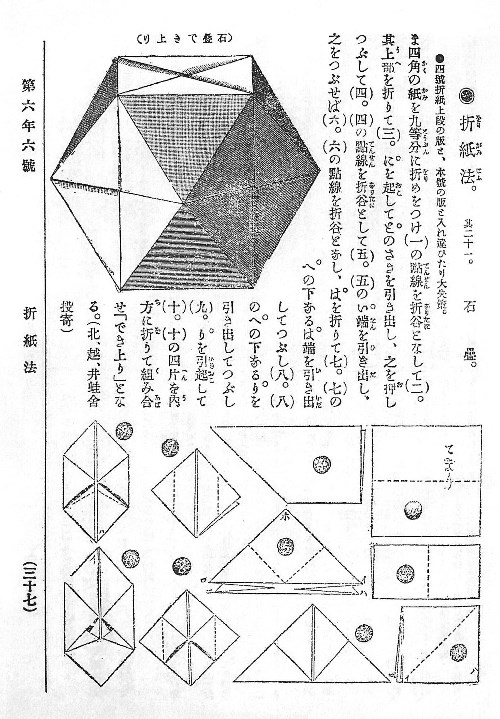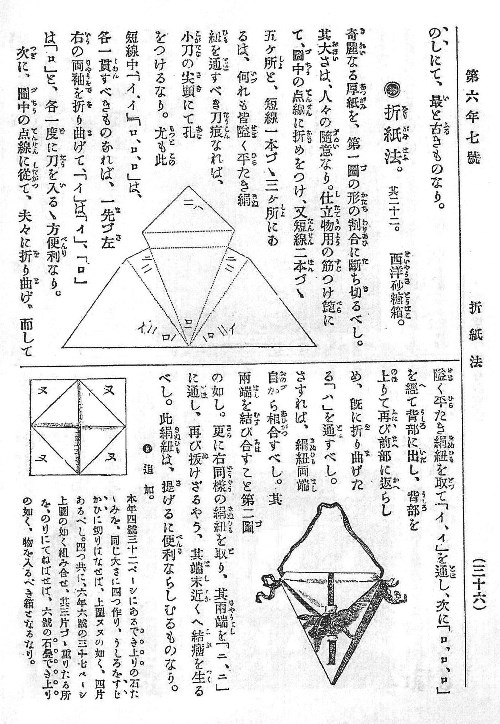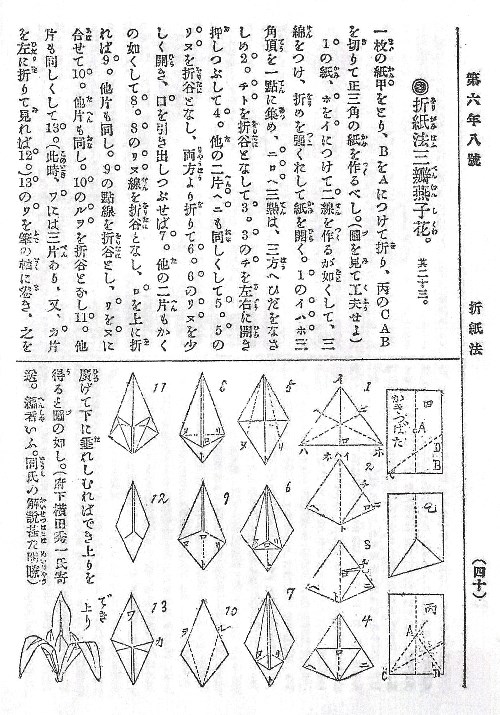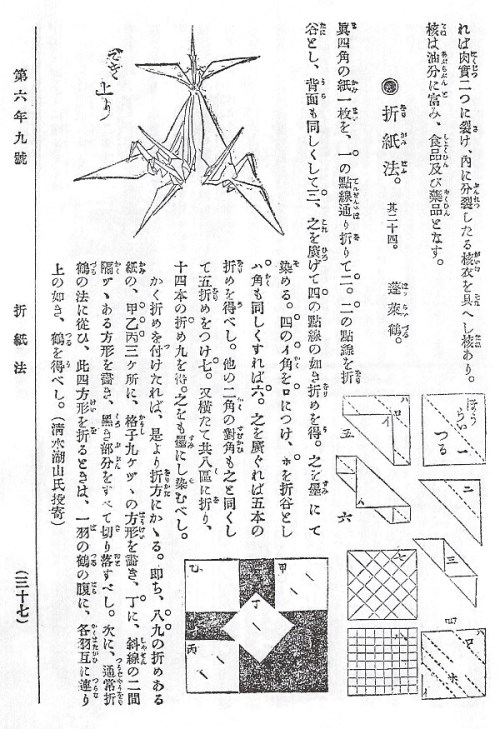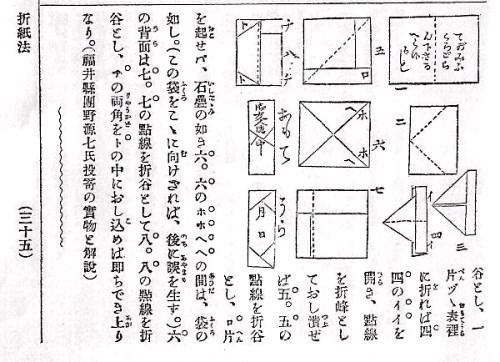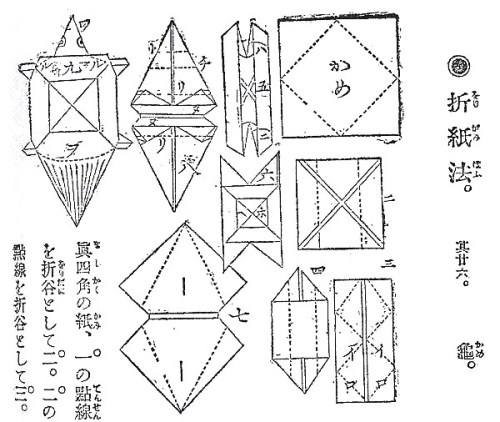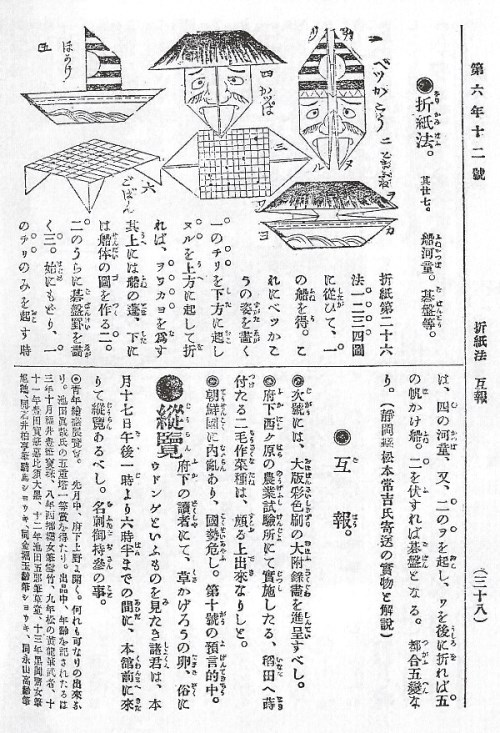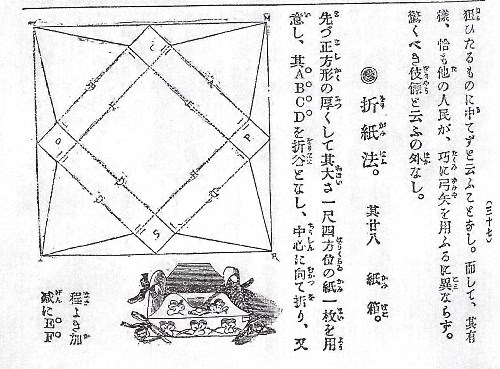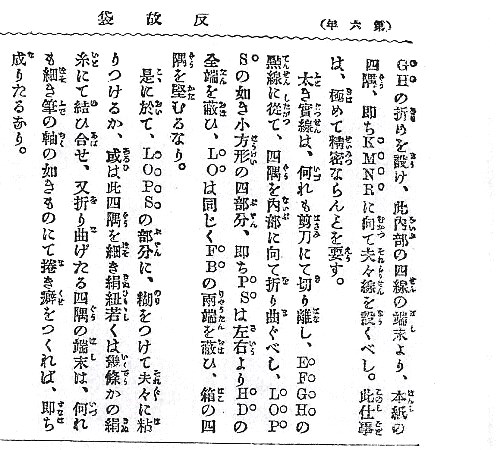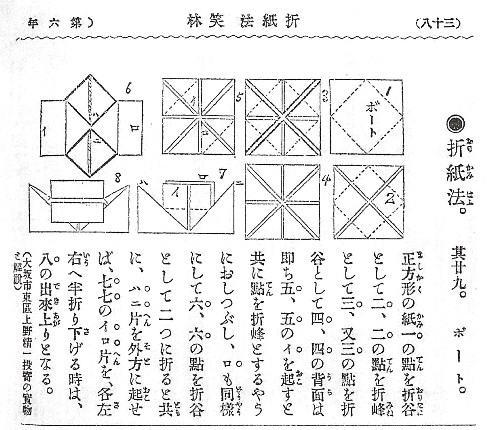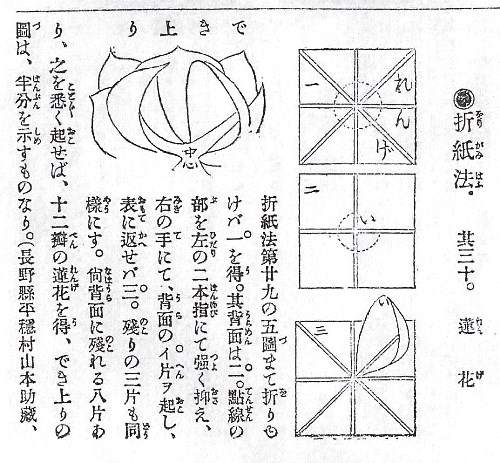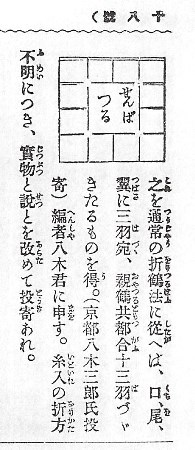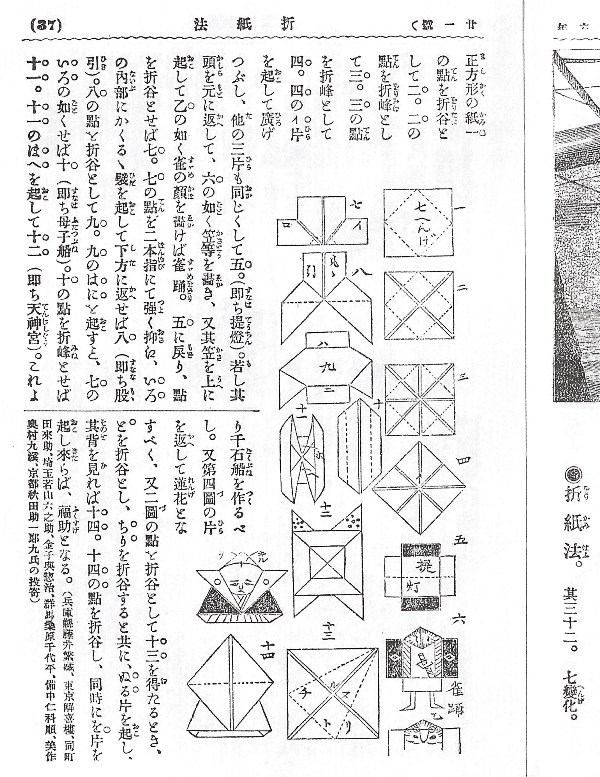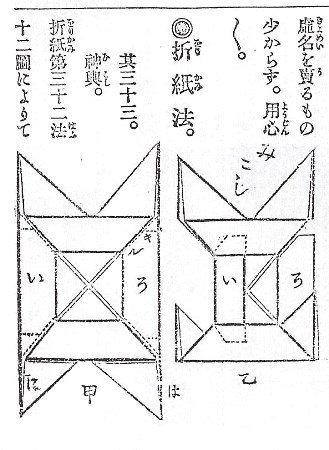| The Public Paperfolding History Project
Last updated 24/1/2024 x |
|||||||
| Articles in Shokokumin Magazine 1894 | |||||||
| Between
1893 and 1896 a number of articles explaining (mostly)
simple paperfolds, mostly under the generic title
'Origami Method', were published in 'Shokokumin' (Young
National) children's magazine. (Information from search
for records mentioning origami in the database of the
National Diet Library.) This magazine seems to have been
published bi-monthly, with 24 issues per year. This page provides details of the articles published in 1894. My thanks to Nobuko Okabe for kindly obtaining details of those of the articles shown below and explaining to me what the articles say and some of the cultural meaning behind the words. The designs were contributed by readers of the magazine living in many different parts of Japan. We cannot tell from the names whether they were adult readers or children. It seems reasonable to assume that these designs, which are noteworthy for their variety, are a good representation of the kind of designs that were in circulation within Japanese society at this time. ********** (Note: the last article published in 1893 was no 14, and thus there appear to be two missing articles. This is, however, not the case. The Editor's numbering system includes two designs - The Crane (#15) and Paper Sengokubune (#16) for which folding instructions were not published. See Editor's note in Article 17 below.) ********** Article 17 in issue 6/1 - Chochin (Lantern) - The Long Lantern Contributor: Kinzaburo Yamashita from Kyoto. After giving the folding instructions the editor says: 'Crane (published #15) and Paper Sengokubune (Paper Sengoku Ship) (#16) are so ordinary, I (the editor) didn’t include folding instructions. Also, after starting we have published Crab (#1), Box (#2), Western Person (#3), Kimono (#4), Kangaroo and Frog (#6), Fukusuke (#7), Kabuto (#8), Chiritori (Dust Pan) (#9), Cat (#10), Boat (#11), Catfish (#12), Sanbo (#13), and Purse (or Coin Case) (#14). Since old days of this country, it seems there have been no examples that collect this many origami methods. We still have ten more contributions here and will publish them in later issues and expand our collection.'
********** Article 18 in issue 6/2 - Kakitsubata (Swallow Flower) - The Lily Contributor: Jusuke Moritani (or Moriya) from Yokohama City
********** Article19 in issue 6/3 - Semi (Cicada) - The Kabuto-Base Cicada Contributor: Hirokata Esashiya of Iwate Prefecture
********** Article 20 in issue 6/4 - The Hexagonal Tematebako (1) and the Waterbomb (1) The upper half of the page contains diagrams for the module for the Hexagonal Tematebako, referred to as 'Ishidatami' (cobblestone), while the lower half contains an illustration of / instructions for making the Waterbomb, referred to as 'Temari' (ball). Issue 6 states that this was an error on the editor's part. The other half of both these sets of instructions appears in that issue. Contributor of the Hexagonal Tematebako: Seiasha (possibly not an individual but a group) of Hoku-Etsu (an area in the northern part of Japan). Contributor of the Waterbomb: Mitsunosuke Kojima of Hyogo Prefecture.
********** Article 21 in issue 6/6 - The Hexagonal Tematebako (2) and the Waterbomb (2) The upper half of the page contains an illustration of /the Hexagonal Tematebako and a written explanation of how to for fold the necessary module (which ought to have been published in Issue 5). The lower half contains diagrams showing how to fold the Waterbomb (the written explanation for which was published in Issue 5).
********** Article 22 in issue 6/7 - Western Sugar Box and the Hexagonal Tematebako (3) This issue contains instructions for the assembly of the Hexagonal Tematebako.
********** Article 23 in issue 6/8 - Three-Petal Swallow Flower (or Three-petal Iris) - The Iris From an equilateral triangle. Contributor: Hidekazu (or Shuichi) Yokota of Tokyo
********** Article 24 in issue 6/9 - Horai - Connected Cranes design From four connected squares. Contributor: Kozan Shimizu ('Horai' is the name of a holy mountain in old Chinese stories. There is a similar design (but made in a different way), in the 'Senbazuru Orikata', where a note explains that the three cranes that form the base of the design resemble a mountain.)
********** Article 25 in issue 6/10 - Shojo-kawa (Wrapper for Certificate) Contributor: Genshichi Danno of Fukui Prefecture
********** Article 26 in issue 6/11 - Game (Turtle) - Minogame Contributor: Tatsuzo Ishida of Yamanashi Prefecture This design is developed from the Tenjin Shrine (though it is called the Tenmangu Shrine here.)
********** Article 27 in issue 6/12 - Japanese Folding Picture Form (Double Boat / The Ship / The Boat with Sail) / The Table) Contributor: Tsunekichi Matsumoto of Shizuoka Prefecture The instructions say that you should make a boat following diagrams 1-4 of Article 26 (the previous issue). Then you draw on each part of the boat as shown in the pictures. When you arrange the flaps in different positions, as shown, the model can be five different things. 1. (upper right) Bekkako (a type of toy with a funny face) 2. (lower right) Tomabune (a boat with a roof made of woven straw). (This is like a flattened Double Boat, except that one of the two boats is depicted as a roof.) 3. (upper middle) Kappa - a yokai, a mythical creature in Japanese folklore. 4. (upper left) Hokake(bune) - the Boat with Sail. 5. (lower middle and left) - Goban (Go Board) ie the Table. (The illustration of this design appears to have been badly drawn. Note that if this design is made from the same sheet of paper the table's legs will not be white but will show parts of the other patterns.)
********** Article 28 in issue 6/13 - Paper Box - Cardboard Modelling Name of contributor not given. The instructions say to cut out the shape along the outer line then either to glue or tie the corners together.
********** Article 29 in issue 6/15 - Boat (adaptation of the Steamship) The katakana characters read ??? (Bo-o-to) Contributor: Seiichi Ueno of Osaka
********** Article 30 in issue 6/16 - Renge (lotus flower) - The Lotus Contributors: Sukezo Yamamoto of Hirao Village, Nagano Prefecture and Shigenobu Kimura of Meirin School in Hyogo Prefecture.
********** Article 31 in issue 6/18 - 13 Connected Cranes - Connected Cranes Contributor: Saburo Yagi of Kyoto
********** Article 32 in issue 6/21 - Shichi-Henge (Seven Changes) (The title can mean literally seven changes, or it can be used figuratively to describe something that changes a lot or often.) The designs illustrated or mentioned in the text are: 1. Chochin (Lantern) - The Cross *** 2. Renge (lotus flower) - The Lotus The article mentions that it is possible to develop a lotus flower from step 4 by flipping the corners. No illustration of this design is given. *** 3. Suzume Odori (Sparrow Dance) - Yakkosan The top picture shows the design decorated to create a character wearing a sword and a woven straw hat. The second shows the same design with the head flipped backwards to reveal the face of a sparrow. This may be a representation of a dance that became popular in the early 19th century when a person would dress up like the top picture and then dance mimicking the movements of a sparrow. *** 4. Momohiki - The Trousers Momohiki are a type of leggings worn by workers. *** 5. Futatsubune - Double Boat *** 6. Tenjin Shrine (The pattern of six dots on the top flaps is the family crest of Tenjin (plum flower)) *** 7. Sengokubune - another name for the Takarabune Derived from the Tenjin Shrine. Mentioned but not illustrated. (Sengoku means a large amount of grain, hence wealth or treasure) *** 8. Fukusuke - Simple Fukusuke *** (Note that while the designs known in Western Europe as the Hat and the Jacket are pictured here they are not named in the text as separate designs but are just treated as intermediate steps) *** Contributors: Shigezo Fujii of Hyogo Prefecture, Kaikiro of Tokyo, Kisuke Machida of Tokyo, Rokunosuke Wakayama of Saitama Prefecture, Yosouji Kaneko (no place name given), Chiyohei Kuwahara of Gunma Prefecture, Jun Nishina of Bicchu, Kukei Okumura of Mimasaka and Sukeichiro Akita of Kyoto.
********** Article 33 in issue 6/23 - Mikoshi A mikoshi is a portable shrine for kami that is carried in a parade. The instructions say 'start from Diagram 12 of Origami Method 32' (ie from the Tenjin Shrine). This design is developed from the Tenjin Shrine using cuts. Contributor: Toramtatsu Yamada of Tokyo.
********** |
|||||||
